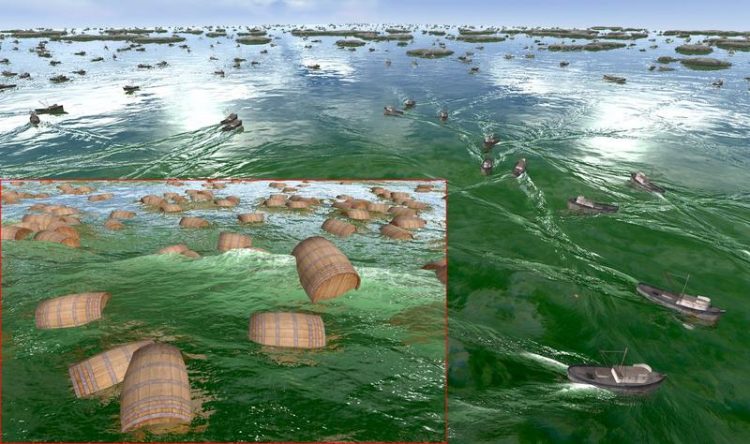New water simulation captures small details even in large scenes

A frame from a real-time animation. The simulation covers a huge area with hundreds of floating objects, but can still include tiny details visible only at close range. Stefan Jeschke
When designers select a method for simulating water and waves, they have to choose either fast computation or realistic effects; state-of-the-art methods are only able to optimize one or the other. Now, a method developed by researchers at the Institute of Science and Technology Austria (IST Austria) and NVIDIA bridges this gap.
Their simulation method can reproduce complex interactions with the environment and tiny details over huge areas—all in real time. Moreover, the basic construction of the method allows graphics designers to easily create artistic effects. The authors will present their work at the annual top conference for computer graphics: SIGGRAPH 2018, where IST Austria researchers are presenting a total of five different projects.
Current water wave simulations are based on one of two available methods. “Fourier-based” methods are efficient but cannot model complicated interactions, such as water hitting shore of an island.
“Numerical” methods, on the other hand, can simulate a wide range of such effects, but are much more expensive computationally. As a result, “scenes with details at the level of tiny waves and with environmental interactions at the level of kilometer-long islands were either impossible or completely impractical,” says Chris Wojtan, professor at IST Austria.
“Our method makes that breadth of scale and range possible, in real time.” The team behind the new method comprises Tomáš Skřivan of IST Austria, as well as Stefan Jeschke, Matthias Müller-Fischer, Nuttapong Chentanez, and Miles Macklin of NVIDIA, in addition to Wojtan.
Achieving all of this required ingenuity, as well as a deep understanding of the basic physics involved. “We encoded the waves with different physical parameters than people previously used,” explains Wojtan. “Essentially, this gave us values that changed much more slowly, which is what allowed us to simulate small details at very large resolution.”
These details make possible a variety of effects that were previously unattainable or extremely expensive computationally, such as objects landing realistically in water (or even thousands of objects landing simultaneously!), or water reflecting off the sides of a moving boat.
Jeschke, first author and former IST Austria postdoc, emphasizes the possible applications in creating detailed and artistic simulations, for instance for games, films, or virtual reality programs. “The combination of range, detail, and computational speed represents a big step forward for the industry,” he says. “Plus, because of how we encode our simulation, it is easy to manipulate it and model water flow in varying environments like rivers or oceans. Our method allows artists to easily ‘overwrite’ nature, and create scenes faster than ever before.”
The team has already designed one such tool: the “wave-painter” works like the paintbrush in a drawing program, increasing the height of the waves as the artist “draws” on a particular area. The wave-painter can also be adapted to create waves flowing in a particular direction as seen in rivers, for example.
Watch the simulation in action here:
http://pub.ist.ac.at/group_wojtan/projects/2018_Jeschke_WaterSurfaceWavelets/Wat…
and here:
http://pub.ist.ac.at/group_wojtan/projects/2018_Jeschke_WaterSurfaceWavelets/Wat…
Project page (including paper): http://visualcomputing.ist.ac.at/publications/2018/WSW/
About IST Austria
The Institute of Science and Technology (IST Austria) is a PhD-granting research institution located in Klosterneuburg, 18 km from the center of Vienna, Austria. Inaugurated in 2009, the Institute is dedicated to basic research in the natural and mathematical sciences. IST Austria employs professors on a tenure-track system, postdoctoral fellows, and doctoral students. While dedicated to the principle of curiosity-driven research, the Institute owns the rights to all scientific discoveries and is committed to promote their use. The first president of IST Austria is Thomas A. Henzinger, a leading computer scientist and former professor at the University of California in Berkeley, USA, and the EPFL in Lausanne, Switzerland. The graduate school of IST Austria offers fully-funded PhD positions to highly qualified candidates with a bachelor's or master's degree in biology, neuroscience, mathematics, computer science, physics, and related areas. http://www.ist.ac.at
Stefan Jeschke
jeschke@stefan-jeschke.com
Stefan Jeschke, Tomáš Skřivan, Matthias Müller-Fischer, Nuttapong Chentanez, Miles Macklin, and Chris Wojtan. 2018. Water Surface Wavelets. ACM Trans. Graph. 37, 4, Article 1 (August 2018), 13 pages. https://doi.org/10.1145/3197517.3201336
http://pub.ist.ac.at/group_wojtan/projects/2018_Jeschke_WaterSurfaceWavelets/Wat…
http://pub.ist.ac.at/group_wojtan/projects/2018_Jeschke_WaterSurfaceWavelets/Wat… Example of simulations
http://pub.ist.ac.at/group_wojtan/projects/2018_Jeschke_WaterSurfaceWavelets/Wat… More examples
http://visualcomputing.ist.ac.at/publications/2018/WSW/ Project page
Media Contact
All latest news from the category: Information Technology
Here you can find a summary of innovations in the fields of information and data processing and up-to-date developments on IT equipment and hardware.
This area covers topics such as IT services, IT architectures, IT management and telecommunications.
Newest articles

Hyperspectral imaging lidar system achieves remote plastic identification
New technology could remotely identify various types of plastics, offering a valuable tool for future monitoring and analysis of oceanic plastic pollution. Researchers have developed a new hyperspectral Raman imaging…

SwRI awarded $26 million to develop NOAA magnetometers
SW-MAG data will help NOAA predict, mitigate the effects of space weather. NASA and the National Oceanic and Atmospheric Administration (NOAA) recently awarded Southwest Research Institute a $26 million contract…

Protein that helps cancer cells dodge CAR T cell therapy
Discovery could lead to new treatments for blood cancer patients currently facing limited options. Scientists at City of Hope®, one of the largest and most advanced cancer research and treatment…



